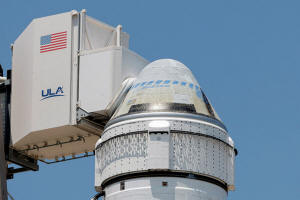Boeing Starliner's crew debut delayed again over spacecraft issue
 Send a link to a friend
Send a link to a friend
 [May 15, 2024]
By Joey Roulette [May 15, 2024]
By Joey Roulette
WASHINGTON (Reuters) -Boeing's first Starliner mission carrying
astronauts into space has been delayed again - until at least May 21 -
over an issue with the spacecraft's propulsion system, the company said
on Tuesday.
Starliner's mission carrying two NASA astronauts had been scheduled for
liftoff from Florida last week until a technical issue with its Atlas 5
rocket prompted a delay to Friday, May 17, the latest postponement for a
program years behind schedule and more than $1.5 billion over budget.
A new technical issue, now concerning Starliner itself, has prompted
another postponement to at least next Tuesday, Boeing said in a
statement.
"Starliner teams are working to resolve a small helium leak detected in
the spacecraft's service module," Boeing said, adding that engineers
traced the leak to a component on one of the propulsion system's 28
control thrusters that are used for maneuvering in Earth's orbit.
Boeing has been developing Starliner for more than a decade to provide
NASA with a second U.S. spacecraft capable of ferrying astronauts to and
from the International Space Station. SpaceX's Crew Dragon capsule,
built under the same NASA program, first launched astronauts to space in
2020.

Starliner's latest mission, called the Crewed Flight Test, is due to be
the final test before the spacecraft is certified by the U.S. space
agency to fly routine astronaut missions to the ISS. Boeing completed an
uncrewed Starliner trip to the ISS in 2022 following years of technical
and management issues.

[to top of second column]
|

A United Launch Alliance Atlas V rocket stands on the pad
after the launch of two astronauts aboard Boeing's Starliner-1 Crew
Flight Test (CFT) was delayed for technical issues prior to a
mission to the International Space Station, in Cape Canaveral,
Florida, U.S. May 7, 2024. REUTERS/Joe Skipper

NASA officials and Boeing engineers will run tests and try to fix
the helium leak before the next possible launch window on May 21 at
4:43 p.m. ET (2043 GMT). Helium is used on Starliner to pressurize
the fuel that powers the spacecraft's thrusters for orbital
maneuvering.
The Atlas 5 rocket, built by the Boeing and Lockheed Martin joint
venture United Launch Alliance (ULA), launches Starliner into space.
Before attempting to launch Starliner last week, ULA discovered a
faulty valve on the Atlas 5 and rolled the rocket off the launchpad
to replace the valve.
Sensors on Starliner first detected suspicious traces of helium
inside the propulsion system while the spacecraft was on the
launchpad last week, but those detections did not raise alarm to
engineers at the time, according to a person briefed on the mission
operations.
Boeing engineers investigated the helium detections while ULA was
replacing the faulty valve on Atlas 5 and determined more testing
and scrutiny was needed in order to meet the mission's strict launch
safety criteria, the person said.
(Reporting by Joey Roulette; Editing by Will Dunham)
[© 2024 Thomson Reuters. All rights reserved.]This material
may not be published, broadcast, rewritten or redistributed.
Thompson Reuters is solely responsible for this content. |